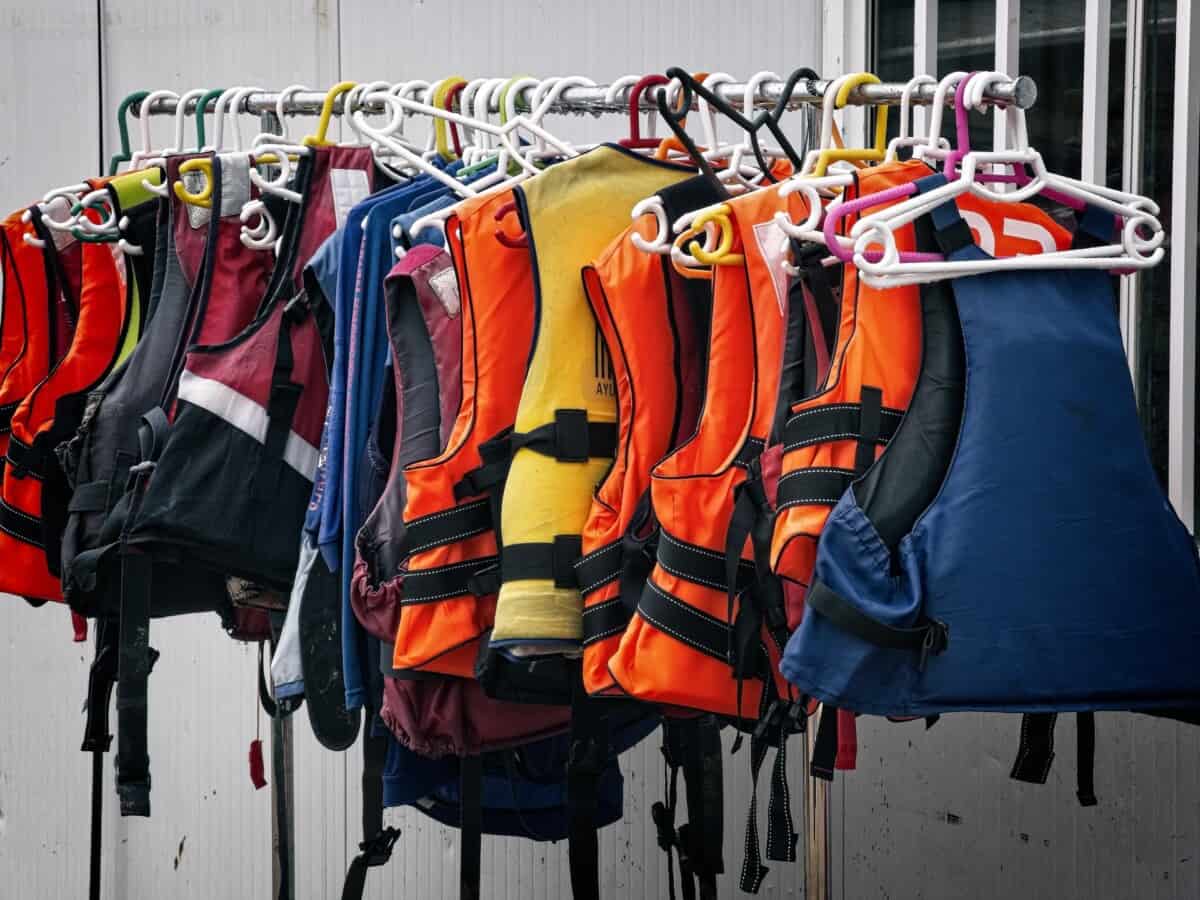When it comes to sailing many people do not understand how the life jacket/vest works and why it floats. Life jackets float because they are made from materials that are buoyant, but it is not enough for them to just simply float.
Life Jacket Definition
What exactly is a life jacket? Now that we understand how life jackets work you might be asking what a life jacket is. A life jacket can be identified as a personal flotation device or PFD is a broad term and refers to any device that aids in flotation or helps keep the wearer afloat.
As such, a life jacket or a life vest can also be considered as a PFD. PFDs are not as bulky as other life jackets, which makes them more comfortable to wear.
Buoyancy Science – How It Works
To understand how life jackets work we must first look at the science behind them. If you were to fall off a boat, it’s unlikely that your first thoughts would involve the ancient Greek philosopher Archimedes.
However, Archimedes’ principle helps to explain what is happening to your submerged body. As an object is submerged in water, it moves, or displaces, water according to how much it weighs.
Archimedes found that the water will push upward against the object with a force equal to the weight of water that is displaced. How much water is displaced is determined by the density of the object. Density is the measure of how much mass is in an object, related to its volume.
For example: a block of solid steel and a steel ship may both be heavy, but the steel ship has a greater volume of steel in addition to weightless air. It displaces enough water to match its own mass, so it floats.
The buoyant force from below keeps the steel ship afloat. Objects that displace an amount of liquid equal to their weight will float because they receive that upward push from the water.
Life jackets must be designed so they have a lot of lift. When being worn by a person it does not lower the overall buoyancy of the wearer and the life jacket to the point where both become submerged.

Life Jacket History – How It Came To Be
What about the history behind the jacket? Well the most ancient examples of primitive life jackets can be followed all the way back to inflated bladders, animal skins, or hollow sealed gourds, for support when crossing deep streams and rivers. Purpose-designed buoyant safety devices consisting of simple blocks of wood or cork were used by Norwegian seamen.
In a letter to the Naval Chronicle, dated February 1802. Mr. Abraham Bosquet proposed issuing Royal Navy Ships with the “Strong canvas bags of dimensions, when filled with cork shavings, equal to about that of a bed bolster, coiled in manner like a collar, and sufficiently wide for the head and shoulders to pass through.
Life Jacket Weight Support
Life jackets are measured according to how much additional weight they can support. Jackets for adults provide, at a minimum, buoyancies ranging from 15.5 pounds to 22 pounds (7 kilograms to 10 kilograms).
Since the average person in water needs about seven to 12 additional pounds of buoyancy to float, a life jacket does not have to support the entire physical weight of a human body.
Instead, it supports those seven to 12 pounds, with a few pounds to spare. You could attach an item that weighs less than the minimum buoyancy provided by that life jacket, and the jacket would hold that item without sinking.
Life Jacket Lifespan – How Long Until You Need To Replace
The lifespan of a lifejacket can be limited to ten years. Linked to this ten-year period is the regular servicing of the device every two years and is strongly recommended for all lifejackets and PFDs used in sailing. Many sailors prefer the slim fitting vest that self inflates. With this type of PFD sailors can complete the activities needed.
The most preferred PFD for sailing recently has been the Onyx. Due to its small profile and great performance it has become one of the most well-known brands for sailing. These life jackets have cartridges of carbon dioxide gas sewn into them.
When activated, the gas will release and fill the chambers of the jacket. Some models will activate the release of gas automatically when the jacket is submerged, thanks to a small dissolvable stopper, like a bobbin or a pill.
These devices are made of a water-soluble material, and when they dissolve, the gas is released and inflates the jacket.
Other inflatable models require the wearer to pull a tab to activate inflation. When the user pulls the tab, it pierces the carbon dioxide canisters to release the gas. Both inflatable devices carry tubes that a person can blow into, which provides a secondary way to inflate the jacket.
When replacing or restoring the jacket, you must check that the PFD itself has no leaks by removing the CO2 cylinder and orally inflate the PFD. The PFD should still be firm after several hours. After an inflatable PFD has been inflated using a cylinder, replace the spent cylinder and replace it with one not expired.
These life jackets also offer a light weight and self-adjustable profile. Soft neoprene around the neckline prevents chafing, while the lower section, back and straps are equipped with padded air mesh panels. Reflective piping increases your visibility at night, while the D-ring attachment comes in handy for adding safety accessories like a whistle or torch.
Stow your shades in the padded, fleece-lined sunglasses pocket and your other personal items in the vest’s utility pockets. It’s intended for people aged 16 and older (or over 80 pounds) and is not recommended for weak or non-swimmers. It is mainly for the use of sailing when one has fallen into the water from an accident or being thrown from the boat.
Coast Guard Approval
Inflatable life jackets have been in use since World War II, but the Coast Guard did not approve them for recreational use until the 1990s because of the extra steps involved.
Inflatables have become more reliable, and many people prefer inflatable life jackets because they aren’t at full size until inflated. They are less bulky and more comfortable for all-day use. Inflatable life jackets are recommended only for adults who are strong swimmers.
The Coast Guard has regulated life jackets and other flotation devices in the United States. The Coast Guard has approved five different categories for personal flotation devices (PFDs):
- Type I – Off-shore life jacket
- Type II – Near-shore buoyancy vest
- Type III – Flotation aid
- Type IV – Throwable devices, such as cushions or rings
- Type V – Special use devices, such as float coats and deck suits
Life Savers
When picking out a life jacket, it’s important to consider these characteristics, as well as the types of boating that one will be doing. A Type I PFD is best for open, rough waters and can keep a person afloat for several hours if a rescue will be slow in coming.
Type II and Type III PFDs are better for inland and calm waters, when a person can be pulled back aboard a boat fairly and quickly. The flotation type classification can be found on the label above.
So, the next time you decide to go sailing you can refer to this and understand why life vests and jackets float and how buoyancy works. Understanding the science and history behind the life jacket will help you understand a little deeper in detail why one just might save your life one day. As for me.
I have never been sailing, but in the event I do I would love to relate back to something as informing as this and be able to comprehend the concepts of how buoyancy of a PFD.
I would much rather be thrown from a boat with the knowledge of a life vest and to be wearing one, then not knowing how to even keep myself afloat in the instance of not having a PFD.


